2007 CHEVROLET EXPRESS CARGO VAN check transmission fluid
[x] Cancel search: check transmission fluidPage 287 of 458
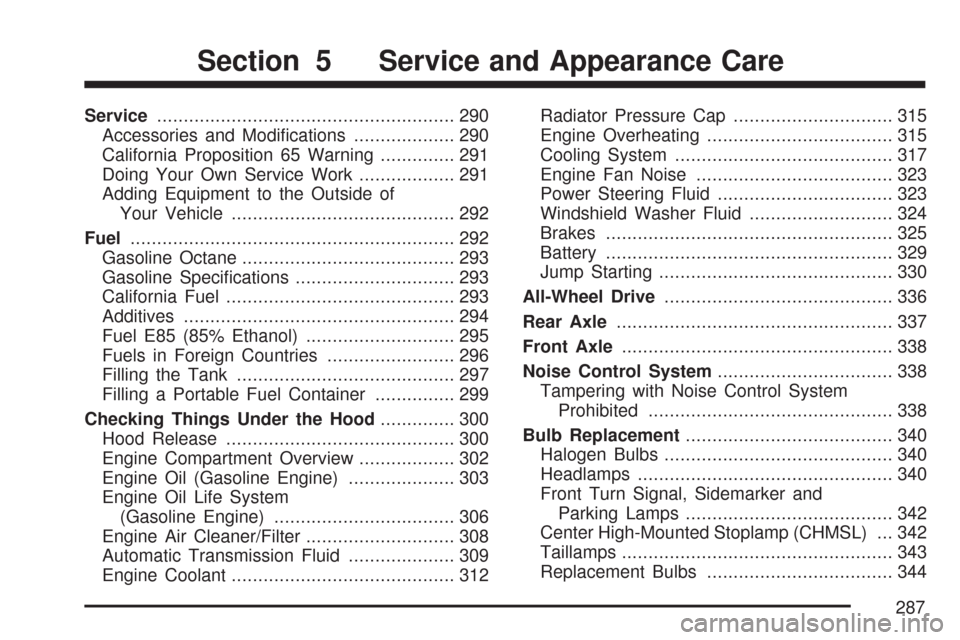
Service........................................................ 290
Accessories and Modifications................... 290
California Proposition 65 Warning.............. 291
Doing Your Own Service Work.................. 291
Adding Equipment to the Outside of
Your Vehicle.......................................... 292
Fuel............................................................. 292
Gasoline Octane........................................ 293
Gasoline Specifications.............................. 293
California Fuel........................................... 293
Additives................................................... 294
Fuel E85 (85% Ethanol)............................ 295
Fuels in Foreign Countries........................ 296
Filling the Tank......................................... 297
Filling a Portable Fuel Container............... 299
Checking Things Under the Hood.............. 300
Hood Release........................................... 300
Engine Compartment Overview.................. 302
Engine Oil (Gasoline Engine).................... 303
Engine Oil Life System
(Gasoline Engine).................................. 306
Engine Air Cleaner/Filter............................ 308
Automatic Transmission Fluid.................... 309
Engine Coolant.......................................... 312Radiator Pressure Cap.............................. 315
Engine Overheating................................... 315
Cooling System......................................... 317
Engine Fan Noise..................................... 323
Power Steering Fluid................................. 323
Windshield Washer Fluid........................... 324
Brakes...................................................... 325
Battery...................................................... 329
Jump Starting............................................ 330
All-Wheel Drive........................................... 336
Rear Axle.................................................... 337
Front Axle................................................... 338
Noise Control System................................. 338
Tampering with Noise Control System
Prohibited.............................................. 338
Bulb Replacement....................................... 340
Halogen Bulbs........................................... 340
Headlamps................................................ 340
Front Turn Signal, Sidemarker and
Parking Lamps....................................... 342
Center High-Mounted Stoplamp (CHMSL) ... 342
Taillamps................................................... 343
Replacement Bulbs................................... 344
Section 5 Service and Appearance Care
287
Page 303 of 458
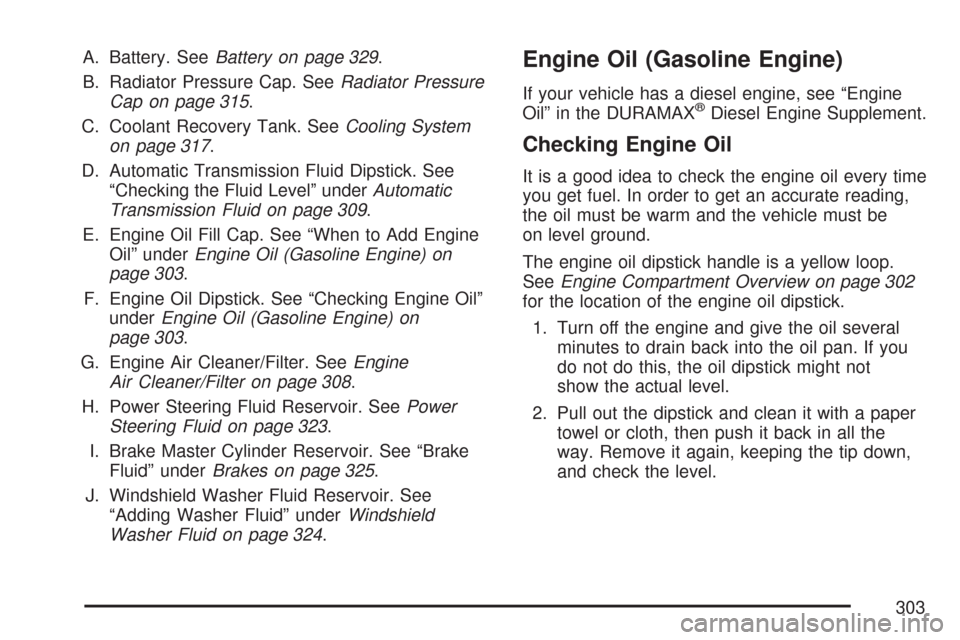
A. Battery. SeeBattery on page 329.
B. Radiator Pressure Cap. SeeRadiator Pressure
Cap on page 315.
C. Coolant Recovery Tank. SeeCooling System
on page 317.
D. Automatic Transmission Fluid Dipstick. See
“Checking the Fluid Level” underAutomatic
Transmission Fluid on page 309.
E. Engine Oil Fill Cap. See “When to Add Engine
Oil” underEngine Oil (Gasoline Engine) on
page 303.
F. Engine Oil Dipstick. See “Checking Engine Oil”
underEngine Oil (Gasoline Engine) on
page 303.
G. Engine Air Cleaner/Filter. SeeEngine
Air Cleaner/Filter on page 308.
H. Power Steering Fluid Reservoir. SeePower
Steering Fluid on page 323.
I. Brake Master Cylinder Reservoir. See “Brake
Fluid” underBrakes on page 325.
J. Windshield Washer Fluid Reservoir. See
“Adding Washer Fluid” underWindshield
Washer Fluid on page 324.Engine Oil (Gasoline Engine)
If your vehicle has a diesel engine, see “Engine
Oil” in the DURAMAX®Diesel Engine Supplement.
Checking Engine Oil
It is a good idea to check the engine oil every time
you get fuel. In order to get an accurate reading,
the oil must be warm and the vehicle must be
on level ground.
The engine oil dipstick handle is a yellow loop.
SeeEngine Compartment Overview on page 302
for the location of the engine oil dipstick.
1. Turn off the engine and give the oil several
minutes to drain back into the oil pan. If you
do not do this, the oil dipstick might not
show the actual level.
2. Pull out the dipstick and clean it with a paper
towel or cloth, then push it back in all the
way. Remove it again, keeping the tip down,
and check the level.
303
Page 309 of 458
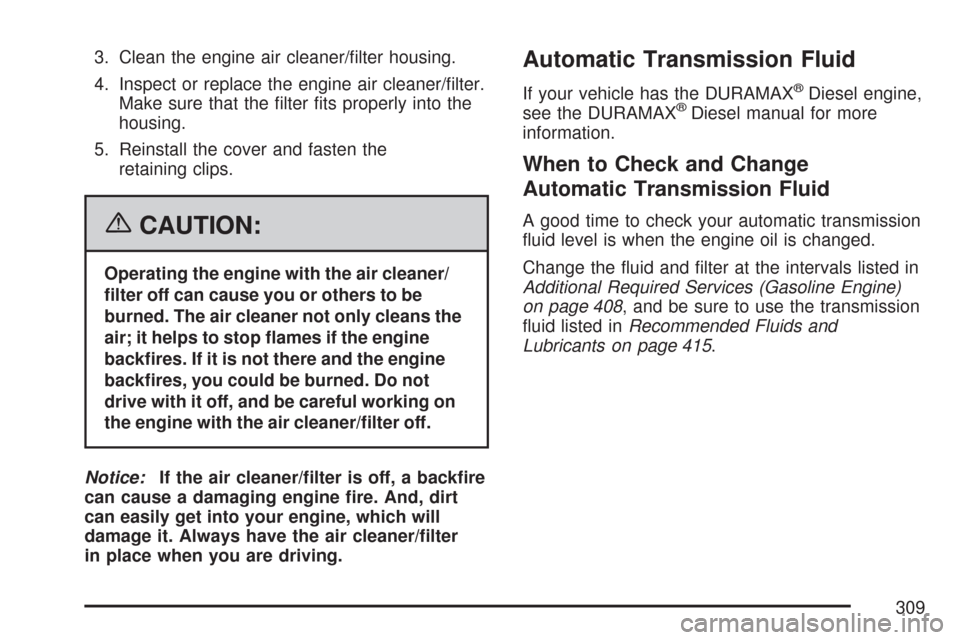
3. Clean the engine air cleaner/filter housing.
4. Inspect or replace the engine air cleaner/filter.
Make sure that the filter fits properly into the
housing.
5. Reinstall the cover and fasten the
retaining clips.
{CAUTION:
Operating the engine with the air cleaner/
�lter off can cause you or others to be
burned. The air cleaner not only cleans the
air; it helps to stop �ames if the engine
back�res. If it is not there and the engine
back�res, you could be burned. Do not
drive with it off, and be careful working on
the engine with the air cleaner/�lter off.
Notice:If the air cleaner/�lter is off, a back�re
can cause a damaging engine �re. And, dirt
can easily get into your engine, which will
damage it. Always have the air cleaner/�lter
in place when you are driving.
Automatic Transmission Fluid
If your vehicle has the DURAMAX®Diesel engine,
see the DURAMAX®Diesel manual for more
information.
When to Check and Change
Automatic Transmission Fluid
A good time to check your automatic transmission
fluid level is when the engine oil is changed.
Change the fluid and filter at the intervals listed in
Additional Required Services (Gasoline Engine)
on page 408, and be sure to use the transmission
fluid listed inRecommended Fluids and
Lubricants on page 415.
309
Page 310 of 458
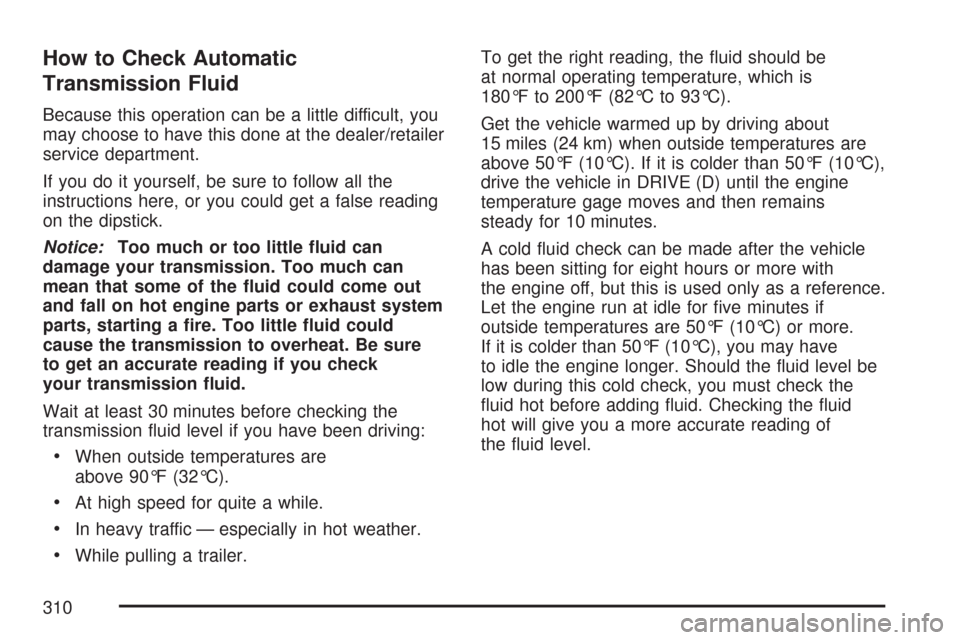
How to Check Automatic
Transmission Fluid
Because this operation can be a little difficult, you
may choose to have this done at the dealer/retailer
service department.
If you do it yourself, be sure to follow all the
instructions here, or you could get a false reading
on the dipstick.
Notice:Too much or too little �uid can
damage your transmission. Too much can
mean that some of the �uid could come out
and fall on hot engine parts or exhaust system
parts, starting a �re. Too little �uid could
cause the transmission to overheat. Be sure
to get an accurate reading if you check
your transmission �uid.
Wait at least 30 minutes before checking the
transmission fluid level if you have been driving:
•When outside temperatures are
above 90°F (32°C).
•At high speed for quite a while.
•In heavy traffic — especially in hot weather.
•While pulling a trailer.To get the right reading, the fluid should be
at normal operating temperature, which is
180°F to 200°F (82°C to 93°C).
Get the vehicle warmed up by driving about
15 miles (24 km) when outside temperatures are
above 50°F (10°C). If it is colder than 50°F (10°C),
drive the vehicle in DRIVE (D) until the engine
temperature gage moves and then remains
steady for 10 minutes.
A cold fluid check can be made after the vehicle
has been sitting for eight hours or more with
the engine off, but this is used only as a reference.
Let the engine run at idle for five minutes if
outside temperatures are 50°F (10°C) or more.
If it is colder than 50°F (10°C), you may have
to idle the engine longer. Should the fluid level be
low during this cold check, you must check the
fluid hot before adding fluid. Checking the fluid
hot will give you a more accurate reading of
the fluid level.
310
Page 311 of 458

Checking the Fluid Level
Prepare your vehicle as follows:
1. Park your vehicle on a level place. Keep the
engine running.
2. With the parking brake applied, place the shift
lever in PARK (P).
3. With your foot on the brake pedal, move the
shift lever through each gear range, pausing
for about three seconds in each range.
Then, position the shift lever in PARK (P).
4. Let the engine run at idle for three minutes
or more.
Then, without shutting off the engine, follow
these steps:
The transmission
dipstick is located near
the center of the
engine compartment
and will be labeled with
the graphic shown.SeeEngine Compartment Overview on page 302
for more information on location.
1. Flip the handle up and then pull out the
dipstick and wipe it with a clean rag or
paper towel.
2. Push it back in all the way, wait three seconds
and then pull it back out again.
3. Check both sides of the dipstick, and read the
lower level. The fluid level must be in the
COLD area for a cold check or in the HOT
or cross-hatched area for a hot check. Be sure
to keep the dipstick pointed down to get an
accurate reading.
4. If the fluid level is in the acceptable range,
push the dipstick back in all the way; then
flip the handle down to lock the dipstick
in place.
311
Page 312 of 458
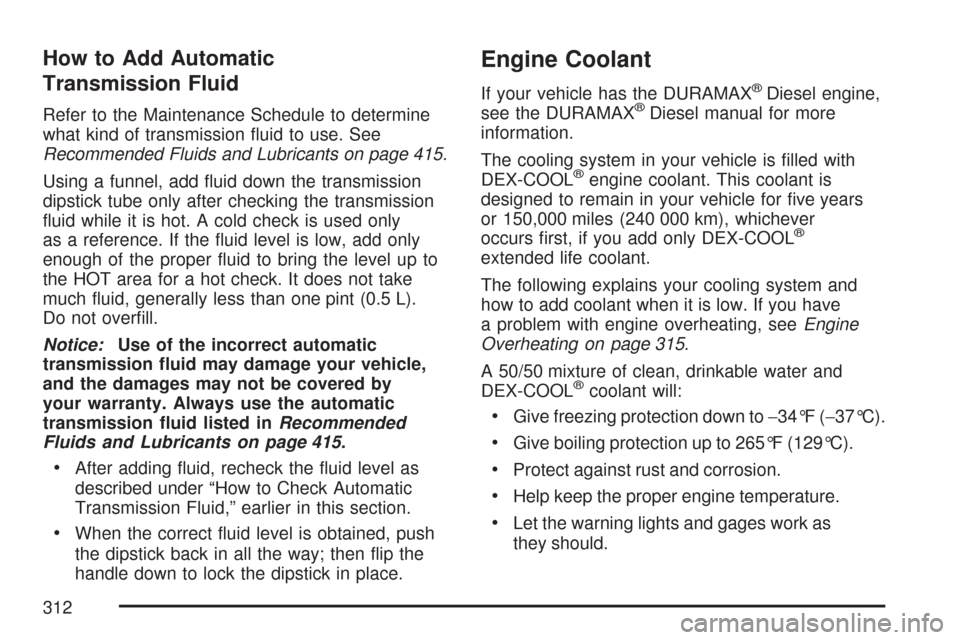
How to Add Automatic
Transmission Fluid
Refer to the Maintenance Schedule to determine
what kind of transmission fluid to use. See
Recommended Fluids and Lubricants on page 415.
Using a funnel, add fluid down the transmission
dipstick tube only after checking the transmission
fluid while it is hot. A cold check is used only
as a reference. If the fluid level is low, add only
enough of the proper fluid to bring the level up to
the HOT area for a hot check. It does not take
much fluid, generally less than one pint (0.5 L).
Do not overfill.
Notice:Use of the incorrect automatic
transmission �uid may damage your vehicle,
and the damages may not be covered by
your warranty. Always use the automatic
transmission �uid listed inRecommended
Fluids and Lubricants on page 415.
•After adding fluid, recheck the fluid level as
described under “How to Check Automatic
Transmission Fluid,” earlier in this section.
•When the correct fluid level is obtained, push
the dipstick back in all the way; then flip the
handle down to lock the dipstick in place.
Engine Coolant
If your vehicle has the DURAMAX®Diesel engine,
see the DURAMAX®Diesel manual for more
information.
The cooling system in your vehicle is filled with
DEX-COOL
®engine coolant. This coolant is
designed to remain in your vehicle for five years
or 150,000 miles (240 000 km), whichever
occurs first, if you add only DEX-COOL
®
extended life coolant.
The following explains your cooling system and
how to add coolant when it is low. If you have
a problem with engine overheating, seeEngine
Overheating on page 315.
A 50/50 mixture of clean, drinkable water and
DEX-COOL
®coolant will:
•Give freezing protection down to−34°F (−37°C).
•Give boiling protection up to 265°F (129°C).
•Protect against rust and corrosion.
•Help keep the proper engine temperature.
•Let the warning lights and gages work as
they should.
312
Page 323 of 458
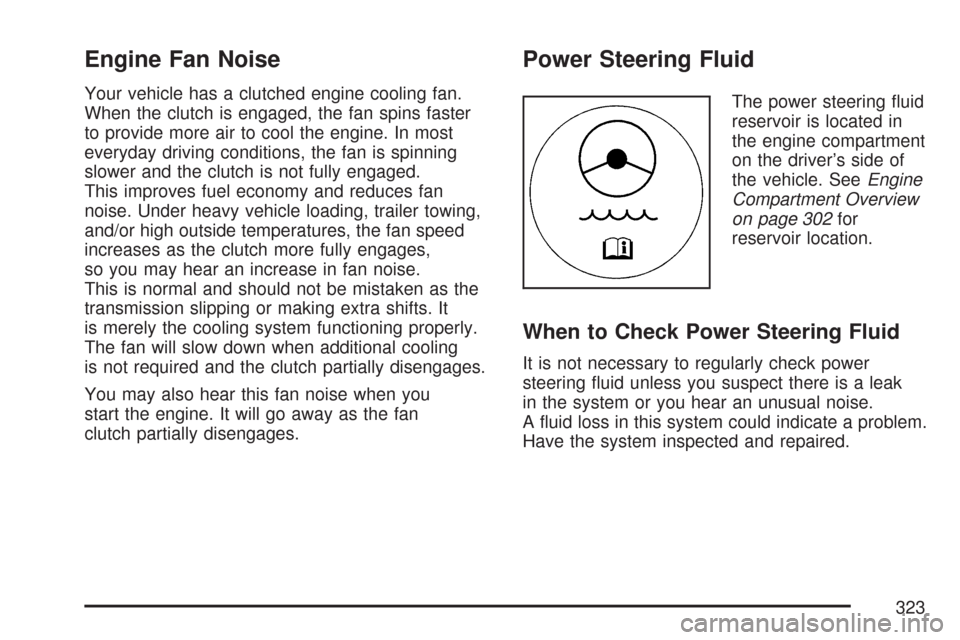
Engine Fan Noise
Your vehicle has a clutched engine cooling fan.
When the clutch is engaged, the fan spins faster
to provide more air to cool the engine. In most
everyday driving conditions, the fan is spinning
slower and the clutch is not fully engaged.
This improves fuel economy and reduces fan
noise. Under heavy vehicle loading, trailer towing,
and/or high outside temperatures, the fan speed
increases as the clutch more fully engages,
so you may hear an increase in fan noise.
This is normal and should not be mistaken as the
transmission slipping or making extra shifts. It
is merely the cooling system functioning properly.
The fan will slow down when additional cooling
is not required and the clutch partially disengages.
You may also hear this fan noise when you
start the engine. It will go away as the fan
clutch partially disengages.
Power Steering Fluid
The power steering fluid
reservoir is located in
the engine compartment
on the driver’s side of
the vehicle. SeeEngine
Compartment Overview
on page 302for
reservoir location.
When to Check Power Steering Fluid
It is not necessary to regularly check power
steering fluid unless you suspect there is a leak
in the system or you hear an unusual noise.
A fluid loss in this system could indicate a problem.
Have the system inspected and repaired.
323
Page 450 of 458
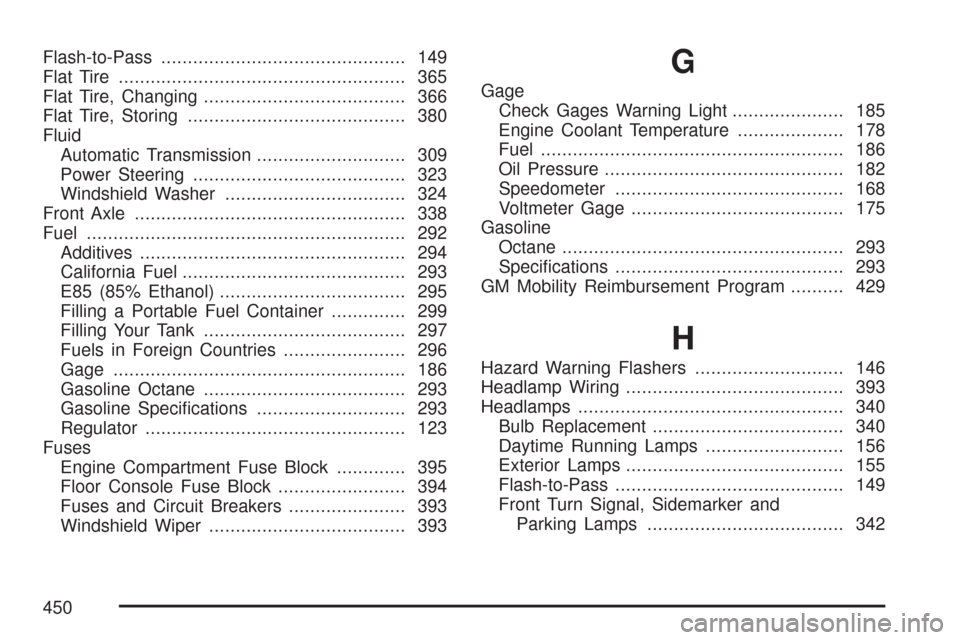
Flash-to-Pass.............................................. 149
Flat Tire...................................................... 365
Flat Tire, Changing...................................... 366
Flat Tire, Storing......................................... 380
Fluid
Automatic Transmission............................ 309
Power Steering........................................ 323
Windshield Washer.................................. 324
Front Axle................................................... 338
Fuel............................................................ 292
Additives.................................................. 294
California Fuel.......................................... 293
E85 (85% Ethanol)................................... 295
Filling a Portable Fuel Container.............. 299
Filling Your Tank...................................... 297
Fuels in Foreign Countries....................... 296
Gage....................................................... 186
Gasoline Octane...................................... 293
Gasoline Specifications............................ 293
Regulator................................................. 123
Fuses
Engine Compartment Fuse Block............. 395
Floor Console Fuse Block........................ 394
Fuses and Circuit Breakers...................... 393
Windshield Wiper..................................... 393G
Gage
Check Gages Warning Light..................... 185
Engine Coolant Temperature.................... 178
Fuel......................................................... 186
Oil Pressure............................................. 182
Speedometer........................................... 168
Voltmeter Gage........................................ 175
Gasoline
Octane..................................................... 293
Specifications........................................... 293
GM Mobility Reimbursement Program.......... 429
H
Hazard Warning Flashers............................ 146
Headlamp Wiring......................................... 393
Headlamps.................................................. 340
Bulb Replacement.................................... 340
Daytime Running Lamps.......................... 156
Exterior Lamps......................................... 155
Flash-to-Pass........................................... 149
Front Turn Signal, Sidemarker and
Parking Lamps..................................... 342
450